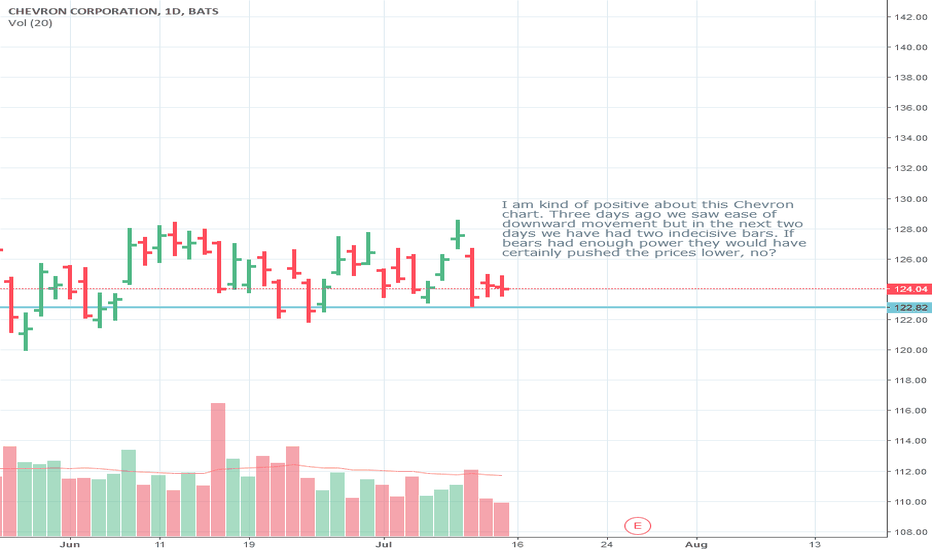CVX trade ideas
Chevron, CVX, Bull Put, Credit SpreadI am not licensed or certified by any individual or institution to give financial advice. I am not a professional Stock trader.
Chevron (CVX) gapped down today, big time; but it couldn't break the 100 Day Exponential Moving Average (EMA). If you look back to October 27, 2017 (see the purple arrow I inserted on the lower left of the chart to mark the date) Chevron did the exact same thing. It proceeded to go back up. I think it will repeat itself in the coming days. It used the 100 Day to bounce and will go back up. I typed up the strategy I used for this play and you should be able to see it on the chart. The 200 Day EMA is sitting just above $118.40ish giving this play more than $4.00 of cushion. Additionally, next week is a short trading week in the United States due to markets being closed on Monday in observation of Memorial Day. That means this Stock has four days to not go down more than four dollars, and the Credit from opening the play is kept. Yes, you could tighten the spread; but having the 200 Day EMA adds a little protection, and I'm still learning how to do Spreads. :)
CVX 10-Day-Ahead Prediction - 04/10-04/19 PeriodArtificial Intelligence/Deep Learning Enabled 10 Day Ahead Predicted values for Chevron Corporation ( CVX ) have been plotted on the chart.
The method used in this prediction is Deep Learning based, and using complex mathematical models/methodologies to extract hidden time series features in vast amounts of CVX related data.
The expected 5 Day Change is 0.822 %
The expected 10 Day Change is 1.409 %
Predictability Indicator is calculated as : 0.675
Predicted 10-Day Ahead Prices are as follows:
Mon Apr 09 Tue Apr 10 Wed Apr 11 Thu Apr 12 Fri Apr 13
115.01 115.20 115.38 115.54 115.70
Mon Apr 16 Tue Apr 17 Wed Apr 18 Thu Apr 19 Fri Apr 20
115.85 115.99 116.12 116.25 116.37
Please note that outliers/non-linearities might occur, however our Artificial Intelligence/Deep Learning Enabled predictions indicate the softened/smoothed moving direction of the stocks/commodities/World indices/ETFs/Foreign Currencies/Cryptocurrencies.
Feel free to contact us for your questions.
CVX on the move upChevron is in a large head and shoulders pattern coming out of good earnigns and dividends. six days after dividends CVX starts to climb which perfectly lines up with the head and shoulders forming. Also, MACD has converged today. Price target 117 on or about March 8, possible continuation on up until march 14. Good Luck I entered today long.
Chevron analysisChevron's weekly trend has been up since June of 2015 and it recently breached a strong weekly support only to quickly get back over it. It has a strong weekly support of 102.69 so as long as the week closes above that price the weekly support will remain in effect.
Now Chevron is trading in a small zone between roughly 108-118.
Some long candles formed with a bottom of around 108 which created a short-term support and Friday's move was pretty bullish. I would expect the uptrend to continue when it closes above 117.90 which is currently the short-term resistance.
Earnings were above expectations a few weeks ago and it is currently trading at last years prices with better earnings.
A close under 108 would indicate more sideways movement for unknown duration. I'll keep you posted. 2/25






















